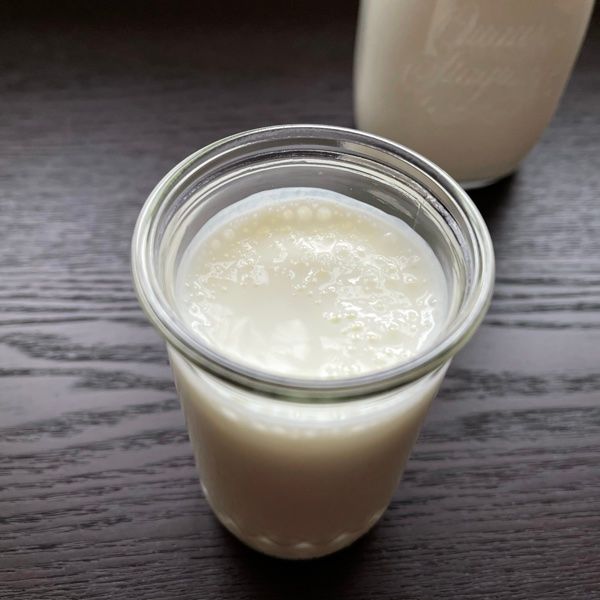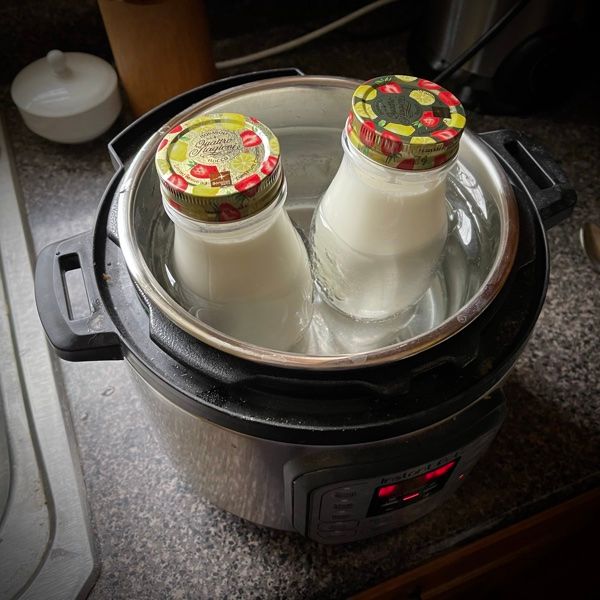How to make drinkable yogurt.

Note: 3/28/21 This recipe has been upgraded to use less starter and a warming time.
A recipe for the Instant Pot.
Drinkable yogurt is wonderfully soothing on the stomach and adds probiotics to your diet that promote whole-body health. If you’ve tried yogurt before and were put off by the tartness, this recipe is mild enough to drink unflavored and absolutely decadent when you add a little honey (which adds even more probiotics.)
INGREDIENTS
- plain yogurt
- vitamin D milk

I make mine in these 13.5 oz bottles so there’s no mess to deal with and the needed measurements are molded on the side. Other than that, all you need is a microwave and an Instant Pot. I use the Instant Pot Duo 3 Quart. (Mine can make three bottles at a time.) Any Instant Pot with a Yogurt setting will work.
DIRECTIONS
- Add milk to the bottle until almost full. I use Organic Valley Whole Milk. It has a wonderful flavor.
- Microwave the bottle until it just starts to bubble and swell. That’s a little over 2 minutes in my microwave. Scalding the milk is necessary to prep it to mingle better with the yogurt cultures. Keep an eye on it since these tapered bottles can overflow easily in the microwave.
- Remove and stir with a wooden chopstick. Since microwaves heat unevenly, this helps make sure all the milk gets hot.
- Set aside to cool and loosely set the lid on top . This keeps out the yeast in the air.
- When cooled to warm-to-the-touch, add a heaping tablespoon of plain yogurt almost to the top and stir with a chopstick until smooth. I use Siggi’s 4% Yogurt. Mixing well will help the bacteria eat the sugars and produce lactic acid more quickly, as well as avoid lumpiness.
- Put the lids on loosely and let bottles sit in an Instant Pot full of water on the Yogurt > 8 Hour setting adjusted to 4 hours. The loose lid allows for swelling resulting from bacterial activity, and keeps out the yeast in the air. With the bottles in the pot, the water should leave about 2 inches of the top of the bottle uncovered. Don’t put the lid in the Instant Pot.
- Remove from the Pot, and stir well with the chopstick. This will remove any lumps that may have formed during incubation.
- Tighten the lids, refrigerate and drink when chilled. Shake well before pouring. Sealed, a bottle keeps for about two weeks in the fridge.
Serving suggestions.
What I really like about this recipe is that the yogurt doesn’t get overly tart and tastes great right out of the bottle. But it has many other uses:
- Mix in honey and vanilla to taste. It’s best to add the honey while the yogurt is still warm. It’s more difficult to mix when chilled. The honey shouldn’t be added earlier in the process, since the bacteria can start eating the honey and may rob some of the honey’s probiotic qualities. Raw honey is best to use and a tablespoon is more than enough to sweeten a bottle.
- Mix in fruit preserves. As with the honey, it’s best to mix these in while the yogurt is still warm so they get thoroughly blended.
- Use as a base for smoothies. In a shaker like a Systema To Go add a little milk, a few ice cubes, vanilla and Nana Flakes.
- Pour over granola. It’s easier to eat than when you use a thick yogurt.
- Use instead of Crema Mexicana. Drizzle over Mexican food as you would enchilada sauce. Tastes great and counteracts some of the heat.
- Use in homemade ranch dressing instead of buttermilk.
FAQ.
- Why can’t I just mix milk and yogurt to make drinkable yogurt? This dilutes the probiotic bacteria, which won’t grow at cooler temperatures. Through controlled warming, the probiotics continue to reproduce to potency.
- Instead of the Yogurt setting, can I just use my Instant pot on the Warm setting? No. The Yogurt > 8 Hour setting has a temperature of 110º, which gives the bacteria an ideal environment to incubate in. The Warm setting can get up to 172º, which kills off the beneficial bacteria.
- How do I tell if my drinkable yogurt is safe to drink? It’s natural that you’d have some skepticism, since the fermentation process is just controlled spoilage. If something went wrong and the yogurt is bad, it will smell like old milk. If it smells like yogurt, you’re good.
- My drinkable yogurt is coming out too tart and too thick. You’ve probably warmed it too long. Note that it will thicken some when it cools. The longer you warm it, the more it thickens into regular yogurt.
- Can I use skim milk and low-fat yogurt? These will work, but the results are kinda thin and blah. Can have an Elmer’s-gluey taste. (I’m not sure how I know that.)
- Can I use ultra pasteurized or UHT milk? No. These don’t work well for cultivating bacteria.
- Can I use dry yogurt starter bacteria? I haven’t tried this, but it should work fine. You want to keep the incubating time to about half what’s recommended on the package to keep the yogurt liquid. There are many types of dry starter, like Bulgarian, Greek, Kefir and Traditional. Experimentation to find one you like can be pricey, so I recommend you stick with the Siggi’s Plain 5.3 oz, more than is enough for 3 bottles.
- Can I use some of the previous batch of liquid yogurt as starter? Yes. Your incubation time will probably be about 5 hours.
- Can I use vegan yogurt starter? These can work with coconut or soy milk. Again, I haven’t tried this so I can’t vouch for the results.
- How is it instead of creamer in coffee? The tart taste is a little much with coffee. Also hot coffee will kill off the probiotics.
This blog makes no money from third-party ads or affilliate links. If you find the recipes useful, please consider buying me a coffee below. It keeps them coming.
